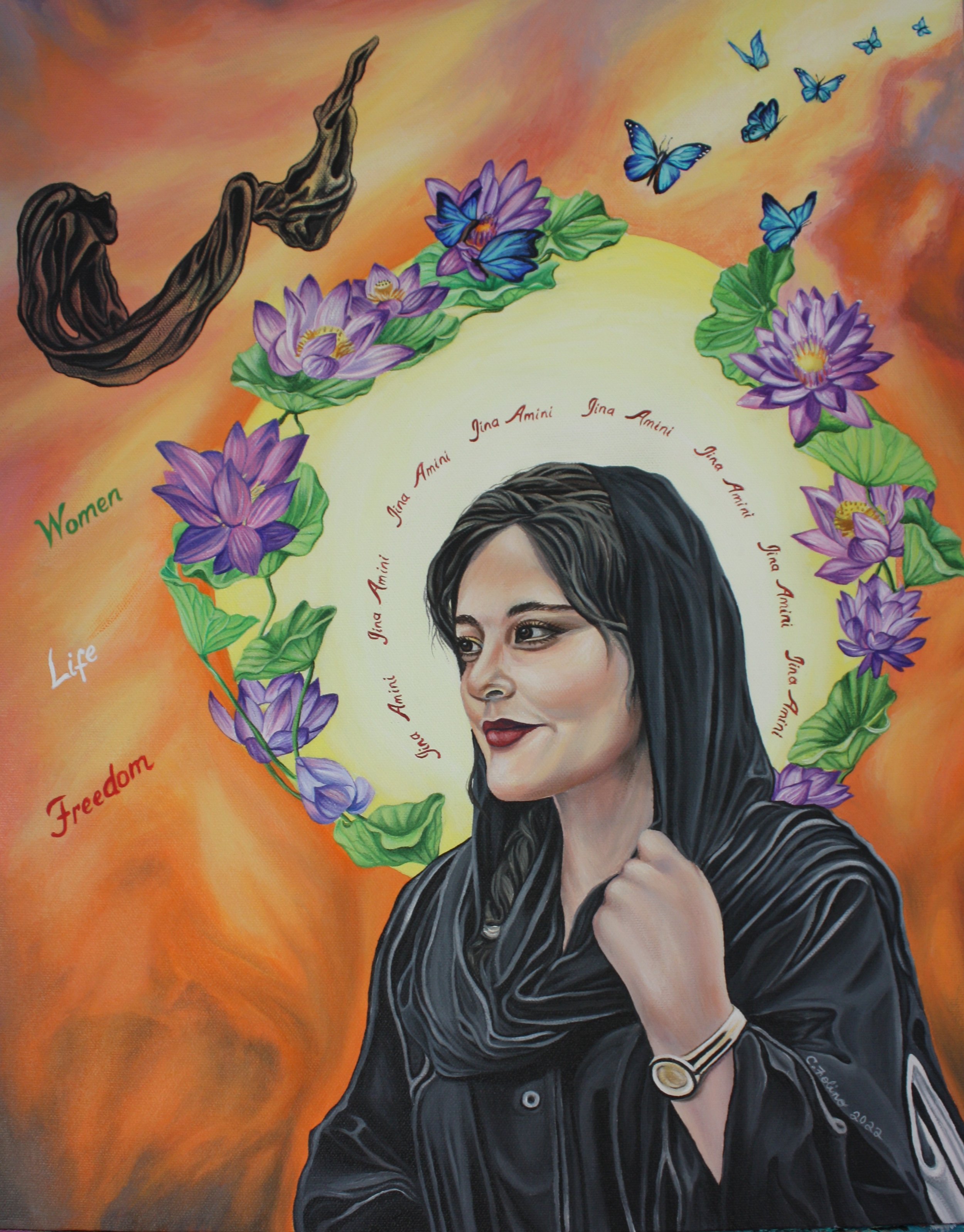Jina (Mahsa) Amini: Women, Life, Freedom Description:
When Mahsa (Jina) Amini died on September 16th, 2022 at the hands of Iran’s morality police, it sparked a myriad of protests across Iran. Amini was arrested and detained by the morality police for wearing her hijab too loosely and wearing red lipstick. She was beaten so badly she was taken to hospital where she died three days later.
After Iran’s Islamic Revolution in 1979, Iran enacted a law requiring women to wear a hijab and cover their bodies, regardless of their faith and nationality. These laws are enforced by Guidance Patrols (coined the “morality police”) and the consequence for violating these laws are fines, imprisonment, and physical violence.
In a show of solidarity since Amini’s death, Iranian women have taken to the streets in protest, burning their hijabs and some cutting off their hair in an act of defiance against Iran’s oppressive laws.
The Iranian government has prevented a lot of video footage of these protests from becoming public by enacting Internet blackouts. Despite this censorship, the feminist revolution that has arisen in Iran has garnered support from women worldwide who identify with this fight against gender apartheid. Perhaps Amini’s death has resonated with some North American women as a result of feeling the sting of the reversal of Roe vs. Wade and the loss of autonomy over reproductive rights for women.
I chose to commemorate Amini in a show of support for Iranian women who are fighting for basic human rights and the right to bodily autonomy. Amini’s death struck a profound chord in me because of its senselessness and brutality. Witnessing the bravery of Iranian women asserting their opposition to the Iranian regime and its laws by removing their hijabs and vocalizing their outrage is a true act of courage. Whether women are fighting to veil or not to veil, people are asserting their right to make that choice independent of government control.
My intention with my portrait of Amini is to express my solidarity with women who want the right to control their own body and have the freedom to make their own choices. I chose to include a halo around Amini’s head to symbolize how her death has illuminated this contentious issue over bodily autonomy and to shine a spotlight on Iran’s misogynistic laws and systemic violence.
I incorporated lotus flowers around the halo as they symbolize femininity, life, and creation in ancient Iranian myths. Lotus flowers also emerge from the mud, and blossom into beautiful flowers, free of any debris. Like the lotus flower, the legacy of Amini’s life will not be tainted by her oppressors. The purity of her spirit has broken through the attempt of law enforcers to silence her choices. Her death has become a catalyst for Iranian women to speak out against these stringent gender laws and sparked support from women around the world who face varying degrees of suppression.
At the top of the canvas, butterflies emerge from the lotus flowers and fly away towards the sunlight. I included butterflies to symbolize Amini’s transformation from life to death. They also represent spiritual rebirth. While her body suffered at the hands of her oppressors, her soul is now free and her legacy offers hope to the next generation of women who face the same fight.
I repeated her name “Jina Amini” inside the halo to honour her life and her ethnically Kurdish name. While many people recognize her name as Mahsa Amini, her mother wanted people to know her by her Kurdish name, Jina (also spelled Zhina), which could not be registered under Iranian law. It is my hope that her name will never be forgotten.
On the left side, I painted a hijab that has been released into the air. This is reflective of the Iranian women who have taken to the streets and removed their head coverings in an act of defiance against Iran’s patriarchal control over their bodies. I included the Kurdish slogan, “Women, Life, Freedom” floating on a diagonal under the hijab to illustrate what mourners and supporters at subsequent protests have cried out in response to Amini’s death. I chose to paint these words in Iran’s flag colours to illustrate Amini’s country of origin.
The bottom of my painting contains fiery oranges and smoky hues to illustrate the turmoil in Iran and to mirror how some protestors are setting fire to their own head coverings. The sunlight breaking through the sky offers hope at newer futures where feminist rhetoric and actions aren’t criminalized and violently repressed.
So whether its Iranian women fighting for their right not to wear a hijab, women fighting for their right to veil, or women standing up for their right to control their reproductive choices, I hope my painting echoes that Amini’s death was not in vain and that the value of personal freedom is priceless.
